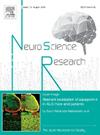Early postural adjustments in cats during a reaching task reflect strategies to predict the forthcoming target location
IF 2.4
4区 医学
Q3 NEUROSCIENCES
引用次数: 0
Abstract
Many types of voluntary movement depend on appropriate postural adjustments. In most situations, such postural adjustments are influenced by learning and are therefore subject to prediction strategies developed through learning. To address how these prediction strategies affect early postural adjustments (EPAs) that occur several hundred milliseconds before movement, we trained two cats in a reaching task where the location of the target was predictable through learning. At the beginning of each trial, the cat stood still with each paw on a force plate for several hundred milliseconds. A target then appeared on either side of a horizontal touch panel, prompting the cat to lift a forepaw. A food reward followed upon holding the target with the forepaw. Target location was alternated every three rewarded trials: one SWITCH followed by two STAY trials. In both cats, EPAs prior to target onset in STAY trials were significantly dependent on the predetermined target location, indicating that they anticipated the target location as a part of their strategy. In SWITCH trials, EPAs aligned with the subsequent STAY trials in both switch directions for one cat, but only in one direction for the other, suggesting that they developed different strategies to handle target location switches.
猫在到达任务中的早期姿势调整反映了预测即将到来的目标位置的策略。
许多类型的自主运动依赖于适当的姿势调整。在大多数情况下,这种姿势调整受到学习的影响,因此受制于通过学习制定的预测策略。为了研究这些预测策略如何影响运动前几百毫秒的早期姿势调整(EPAs),我们训练了两只猫进行一个到达任务,在这个任务中,目标的位置是通过学习预测的。在每次试验开始时,猫的每只爪子都放在测力板上,静止不动几百毫秒。然后,一个目标出现在水平触屏的两侧,促使猫抬起前爪。在用前爪抓住目标后,会得到食物奖励。目标位置每三个奖励试验交替进行:一个切换,然后是两个停留试验。在这两只猫中,在STAY试验中,目标发作之前的EPAs显著依赖于预定的目标位置,表明它们预期目标位置是其策略的一部分。在SWITCH试验中,EPAs与随后的STAY试验在一只猫的两个切换方向上保持一致,但在另一只猫的一个方向上保持一致,这表明它们开发了不同的策略来处理目标位置切换。
本文章由计算机程序翻译,如有差异,请以英文原文为准。
求助全文
约1分钟内获得全文
求助全文
来源期刊

Neuroscience Research
医学-神经科学
CiteScore
5.60
自引率
3.40%
发文量
136
审稿时长
28 days
期刊介绍:
The international journal publishing original full-length research articles, short communications, technical notes, and reviews on all aspects of neuroscience
Neuroscience Research is an international journal for high quality articles in all branches of neuroscience, from the molecular to the behavioral levels. The journal is published in collaboration with the Japan Neuroscience Society and is open to all contributors in the world.
 求助内容:
求助内容: 应助结果提醒方式:
应助结果提醒方式:


